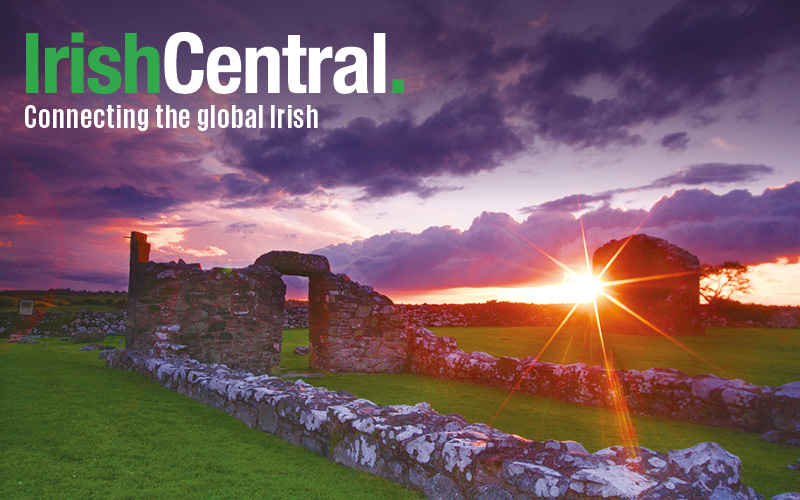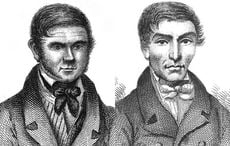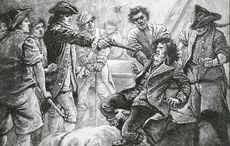An Irish American family makes an odyssey to Rathlin Island in 2018, the small Irish island their ancestors left 170 years ago.
Exactly fifty years ago, in the summer of 1968, my granduncle, a Xaverian brother named Brother Jason Black, C.F.X. and his two nephews - my uncles - Eddie and Vinnie Black, traveled to a small island off the north coast of Ireland in search of our family’s history.
That trip has reverberated through my family ever since. Brother Jason wrote about this trip in a report he entitled “The Blacks of Ballygill," Ballygill being the section of Rathlin Island from which my ancestors came. For most of my life, Rathlin was a mythical place, somewhat like Atlantis.
I would occasionally hear of cousins, inspired by Brother Jason’s research, visiting the island. But I never felt particularly connected to the place. One of my early memories was of the tension at my father’s funeral, three years after Brother Jason’s visit, over an incident that occurred on the island in the year 1642. That’s right, 1642. More about that later.
Read more: Seven hard-won lessons from searching for my Irish ancestors
My relationship with Rathlin changed dramatically in 2007 when my son, Dan, called from his college semester abroad in Ireland. He told me that he was standing on a cliff in a place called Ballycastle and could see Scotland. Knowing that Rathlin was situated between Scotland and Ireland, I asked if he could see an island. He said, “Yes.” “Oh my God!” I exclaimed. “That’s Rathlin!”
He was the first member of my immediate family to lay eyes on Rathlin. Unlike Atlantis, it really did exist. Over the years since then, my obsession with Rathlin has only grown, culminating in an extraordinary family vacation for me and every member of my family.

Credit: Bill Black
What Brother Jason learned from his research was that my great, great grandfather, his grandfather, Archibald Black, left Rathlin in the 1840s during the Great Famine and traveled to Pembroke, Maine, joining other Rathlin Islanders who had emigrated before him. He eventually made his way to Boston, where his great-grandson, my father, William Henry Black was born in 1918.
Unfortunately, genealogical records do not go back very far with respect to Rathlin. Finding family members preceding Archibald has proven difficult. There were three principal families on Rathlin throughout its recorded history, the Blacks, the McFauls and the McCurdys, all of whom populate my family tree. Today, there are McFauls and McCurdys on the island, but all the Blacks can be found in the cemetery at St. Thomas Church.
Tales of Rathlin
Because documentation about our family was thin pre-Archibald, Brother Jason began to study the general history of Rathlin Island, which is rich and dramatic. Probably its most famous story is that of Robert the Bruce, King of Scotland. He was exiled to Rathlin following military defeats at the hand of British King Edward I. Holed up in a sea cave and despondent over his failure to secure Scottish freedom from British domination, he contemplated a spider trying, and repeatedly failing, to climb a rock. The spider fell back six times, just as Robert had failed six times in his efforts to defeat the British.
Robert determined that, on its seventh try, if the spider cleared the rock, he would go back to Scotland for another attempt to secure Scottish freedom. It did and he did, finally claiming the Scottish throne and independence from Britain at the Battle of Bannockburn. That cave can still be seen in a cliff from the sea on the north face of the island.
Throughout its history, Rathlin was the scene of many massacres. One of the worst occurred in 1642 when Sir Duncan Campbell from Scotland attacked a rival clan on Rathlin. Three hundred Rathlin men faced off against 1,600 Campbell soldiers on the north coast of the island at a place called Lag-na-vis-ta vor, “the field of the great battle.” The women and children of the island watched the inevitable slaughter of their men from an overlooking hill called Crocknascriedlin, “the hill of screaming.”
After the Campbells finished off the men, they dragged the women and children to a cliff and threw them to their deaths on the rocky beaches below. The islanders have never forgotten this atrocity and have memorialized it in an exhibit in the historical society.

Love Irish history? Share your favorite stories with other history buffs in the IrishCentral History Facebook group.
This was the incident that caused the tension at my father’s funeral. It arose in the waning hours of the traditional Irish wake that followed the funeral. This was the rare occasion in which my mother’s family, the Singletons, and my father’s family, the Blacks, interacted.
As it was, my mother’s sister Mary had married a man named Paul Campbell and he was in attendance. He was an utterly peaceful man, unlike his Scottish ancestors. Still, while my memory is vague, I recall harsh words being exchanged as a result of the – at the time – recently discovered atrocity. As is often said about the Irish, the last things to go are the grudges.
Rathlin Today
Today’s Rathlin is a place of extraordinary peace and tranquility. There are 140 residents of the island and likely many more sheep and cattle. It is stunningly beautiful with rolling hills, soaring cliffs and rocky shores full of seals and sea lions lolling about. There is one Protestant church and one Catholic church about a quarter-mile apart from one another. There is one schoolhouse.
Remarkably for Ireland, there is only one modern-day cemetery, shared by both denominations. The headstones go back hundreds of years and about a third have the name Black. There is also a significant representation of both the McFauls and the McCurdys.
Read more: Searching for my ancestors in Butte, Montana's famous Irish mining town

Map of Rathlin Island. Credit: Bill Black
Rathlin is also known globally by bird watchers as one of the world’s best places to observe seabirds. Hundreds of thousands of them populate its north face. The combination of high craggy cliffs and churning sea waters make this an ideal feeding ground for a number of species, including guillemots, kittiwakes and razorbills.
But the species that draws the most tourists are the puffins, of which there are hundreds visible in late Spring and early Summer. There are daily excursions to the aviary by Bert’s Puffin Bus, with lively commentary about the island from the driver, Bertie Curry, whose family has lived on Rathlin for generations.
The Blacks Retake Rathlin
At a family gathering in 2017, my sister Susan proposed a family trip to Rathlin in 2018. It was a bold suggestion. We had never traveled together and hadn’t vacationed together since we were kids. In fact, the only time the entire family regularly got together since childhood was at Christmas. My brothers and sister, and our spouses ranged in age from 57 to 65.
The next generation, our children, ranged in age from 18 to 29. There are 18 of us, in all. Would we get along while spending 9 days together 24/7, living out of suitcases? Could the parents and children of four families vacation together successfully? None of us knew for sure. But we decided to go for it.
Any doubts we had about this trip were washed away in the ocean spray from the channel between Ballycastle and Rathlin as we rode the ferry ride to the island. The sight of the dramatic white cliffs facing the mainland, combined with the realization that we were returning to the place that Archibald reluctantly left for good 170 years previously, was emotionally very powerful.

The Manor House. Credit: Bill Black
As we stepped off the ferry in Church Bay, the extraordinarily picturesque commercial center of the island, we were greeted by our cousin, Teresa McFaul. She had arranged every aspect of our visit, including our booking at the Manor House, the only lodging available on the island for a group of our size.
The Manor House is the former home of the Gage family, the British aristocrats who owned most of the island until the early 1970s. We filled all the available rooms. She also arranged for a viewing of a 1957 BBC program on life on Rathlin entitled The Island Betwixt and Between, a grainy black and white documentary that featured many parents and grandparents of current residents of the island. Finally, she moved us with her angelic singing voice at an impromptu music “session” she also arranged in the lobby of the Manor House.
Read more: How to trace your roots in Ireland - tips on finding your Irish ancestors
Our lengthy planning process had the benefit of allowing us to recruit some other “Blacks” to join us on Rathlin, some expected, some unexpected. In the expected category, my cousins Bob and Richard Black, the sons of my uncle Bob Black, signed up early on. Bob is the family genealogist, a role he inherited from Brother Jason upon his death at age 104.
Bob has been nurturing and massaging the Black family tree almost literally his entire life. He knows all the connections on Rathlin that can be known. Richard has visited Rathlin more than any other of the American Blacks. They became our trusted Sherpas.
An unexpected participant in our return to Rathlin was Lyssa Black with whom we share a great-grandfather, Daniel Black. She had a lifelong desire to visit Rathlin and chose this particular time to do so. We discovered her in the historical society building where she had her copy of The Blacks of Ballygill. We had had no previous contact with Lyssa and her presence was completely coincidental.
Also unexpectedly, we were also joined by two members of the famous Black Family singers who have been recording albums and performing in Ireland both as a group and individually since the 1970s. While they all grew up in Dublin, their father, Kevin Black, was born and raised on Rathlin Island and is buried there.
The family still maintains their father’s farmhouse on Rathlin and visits frequently. Michael Black, currently living and singing in San Francisco, joined us, as did his sister, Frances Black a senator in the Irish parliament's Upper House.. Michael was joined by his wife, Sonia and his three incredibly talented daughters, Ciara, Maeve and Catriona.
Frances brought along her daughter, Aoife Scott, who has continued the family music tradition by recently winning the Best Irish Folk Act of the Year at the Annual Irish Post Music Awards. While we have not identified the common ancestor shared by the famous Blacks of Dublin and the not-famous Blacks of Boston, we’re convinced he or she exists and that we are, in fact, cousins.

The kids at the Homestead. Photo: Bill Black
A Fourth of July Céilí
Since we would be on the island for American Independence Day, we decided to host the Black Family Fourth of July Céilí at the Rathlin’s only pub, McQuaig’s, and invite all the island’s residents. A céilí is an Irish dance party that involves lively, foot-stomping music and a variety of complex dances demanding participation by everyone in the room.
While the decorations were American, the music was all Irish. Michael Black led a group of local musicians, playing guitar and banjo for the entire evening (except when he was dancing). Michael’s daughters dazzled us with their Irish step dancing. Aoife Scott sang her hit song All Along the Wild Atlantic Way.
In what was, for me, the emotional high point of the entire trip, Frances Black sang, Rathlin Island, dedicated to her father, Kevin. It is a profoundly moving song that tells the story of a Rathliner leaving the island during the famine, which could have been the story of our ancestor, Archibald.
Read more: Our surprising adventures chasing our ancestors in Ireland

Dancing at the ceili. Credit: Bill Black
Of course, we knew that everyone at an Irish party must be prepared to stand and deliver. Fortunately, my sister Susan was prepared for that. She performed a song suitable for the occasion and the rest of our clan provided the chorus. The song is entitled Back Home to Ireland whose chorus is:
Back home to Ireland for the first time
As I gaze on your fields and your shores
In each Irishman's heart
there's a part of you inside
In my heart, I have been here before.
Read more: How to plan the ultimate ancestry trip and trace your roots in Ireland
McQuaig's. Credit: Bill Black
A Muintir (Family) is Formed
Returning together to the land of our ancestors bonded our family in unexpected ways. We were all deeply moved – and positively changed - by the shared experience, the beauty of the island and the kindness of its residents (our relatives). The two generations in our group bonded through the power of our shared ancestors. We left Rathlin reluctantly, made more so when Michael, Frances, Aoife, and Teresa came to the dock to see us off.
We performed one more rendition of the chorus of Back Home to Ireland as we waved our arms from the ferry and them from the shore. But I could not help recall the chorus of Frances Black’s song, Rathlin Island:
Sail away from the island
Sail out on the sea
Turn a blue eye back on Rathlin
An baile i mo chroí (the home in my heart)
Read more
* Originally published in July 2018.




Comments